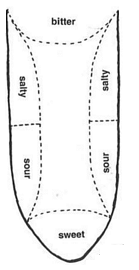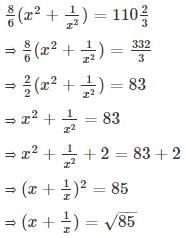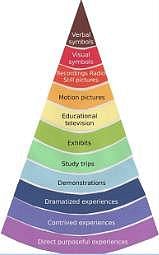Karnataka TET Paper 2 Mock Test - 6 (Science and Mathematics) - Karnataka TET MCQ
30 Questions MCQ Test - Karnataka TET Paper 2 Mock Test - 6 (Science and Mathematics)
Which type of learning mainly influences personality of the child?
Frobel's most important contribution to education was his development of which of the following?
निर्देश: दिए गए पद्यांश को पढकर निम्नलिखित प्रश्नों के सही विकल्प छाँटिएI
क्या रोकेंगे प्रलय मेघ ये, क्या विद्युत-धन के नर्तन,
मुझे न साथी रोक सकेंगे, सागर के गर्जन-तर्जन।
मैं अविराम पथिक अलबेला रुके न मेरे कभी चरण,
शूलों के बदले फूलों का किया न मैंने मित्र चयन।
मैं विपदाओं में मुसकाता नव आशा के दीप लिए
फिर मुझको क्या रोक सकेंगे जीवन के उत्थान-पतन,
मैं अटका कब, कब विचलित में, सतत डगर मेरी संबल
रोक सकी पगले कब मुझको यह युग की प्राचीर निबल
आँधी हो, ओले-वर्षा हों, राह सुपरिचित है मेरी,
फिर मुझको क्या डरा सकेंगे ये जग के खंडन-मंडन।
मुझे डरा पाए कब अंधड़, ज्वालामुखियों के कंपन,
मुझे पथिक कब रोक सके हैं अग्निशिखाओं के नर्तन।
मैं बढ़ता अविराम निरंतर तन-मन में उन्माद लिए,
फिर मुझको क्या डरा सकेंगे, ये बादल-विद्युत नर्तन।
Q. यहाँ 'युग की प्राचीर' से क्या मतलब है?
क्या रोकेंगे प्रलय मेघ ये, क्या विद्युत-धन के नर्तन,
मुझे न साथी रोक सकेंगे, सागर के गर्जन-तर्जन।
मैं अविराम पथिक अलबेला रुके न मेरे कभी चरण,
शूलों के बदले फूलों का किया न मैंने मित्र चयन।
मैं विपदाओं में मुसकाता नव आशा के दीप लिए
फिर मुझको क्या रोक सकेंगे जीवन के उत्थान-पतन,
मैं अटका कब, कब विचलित में, सतत डगर मेरी संबल
रोक सकी पगले कब मुझको यह युग की प्राचीर निबल
आँधी हो, ओले-वर्षा हों, राह सुपरिचित है मेरी,
फिर मुझको क्या डरा सकेंगे ये जग के खंडन-मंडन।
मुझे डरा पाए कब अंधड़, ज्वालामुखियों के कंपन,
मुझे पथिक कब रोक सके हैं अग्निशिखाओं के नर्तन।
मैं बढ़ता अविराम निरंतर तन-मन में उन्माद लिए,
फिर मुझको क्या डरा सकेंगे, ये बादल-विद्युत नर्तन।
निर्देश: गद्यांश को पढ़कर निम्नलिखित प्रश्न में सबसे उचित विकल्प को चुनिए।
प्राचीन भारत में शिक्षा, ज्ञान प्राप्ति का सबसे बड़ा स्रोत माना जाता था। व्यक्ति के जीवन को सन्तुलित और श्रेष्ठ बनाने तथा एक नई दिशा प्रदान करने में शिक्षा का महत्त्वपूर्ण योगदान था। सामाजिक बुराइयों को उसकी जड़ों से निर्मूल करने और त्रुटिपूर्ण जीवन में सुधार करने के लिए शिक्षा की नितान्त आवश्यकता थी। यह एक ऐसी व्यवस्था थी, जिसके द्वारा सम्पूर्ण जीवन ही परिवर्तित किया जा सकता था। व्यक्ति को अपने व्यक्तित्व का विकास करने, वास्तविक ज्ञान को प्राप्त करने और अपनी समस्याओं को दूर करने के लिए शिक्षा पर निर्भर होना पड़ता था। आधुनिक युग की भाँति प्राचीन भारत में भी मनुष्य के चरित्र का उत्थान शिक्षा से ही सम्भव था। सामाजिक उत्तरदायित्वों को निष्ठापूर्वक वहन करना प्रत्येक मानव का परम उद्देश्य माना जाता है। इसके लिए भी शिक्षित होना नितान्त अनिवार्य है। जीवन की वास्तविकता को समझने में शिक्षा का उल्लेखनीय योगदान रहता है। भारतीय मनीषियों ने इस ओर अपना ध्यान केन्द्रित करके शिक्षा को समाज की आधारशिला के रूप में स्वीकार किया। विद्या का स्थान किसी भी वस्तु से बहुत ऊँचा बताया गया। प्रखर बुद्धि एवं सही विवेक के लिए शिक्षा की उपयोगिता को स्वीकार किया गया। यह माना गया कि शिक्षा ही मनुष्य की व्यावहारिक कर्तव्यों का पाठ पढ़ाने और सफल नागरिक बनाने में सक्षम है। इसके माध्यम से व्यक्ति का शारीरिक, मानसिक और आत्मिक अर्थात् सर्वांगीण विकास सम्भव है। शिक्षा ने ही प्राचीन संस्कृति को संरक्षण दिया और इसके प्रसार में मदद की। विद्या का आरम्भ ‘उपनयन संस्कार’ द्वारा होता था। उपनयन संस्कार के महत्त्व पर प्रकाश डालते हुए मनुस्मृति में उल्लेख मिलता है कि गर्भाधान संस्कार द्वारा तो व्यक्ति का शरीर उत्पन्न होता है पर उपनयन संस्कार द्वारा उसका आध्यात्मिक जन्म होता है। प्राचीन काल में बच्चों को शिक्षा प्राप्त करने के लिए आचार्य के पास भेजा जाता था। शतपथ ब्राह्मण के अनुसार, जो ब्रह्मचर्य ग्रहण करता है। वह लम्बी अवधि की यज्ञावधि ग्रहण करता है। छान्दोग्योपनिषद् में उल्लेख मिलता है कि आरुणि ने अपने पुत्र श्वेतकेतु को ब्रह्मचारी रूप से वेदाध्ययन के लिए गुरु के पास जाने को प्रेरित किया था। आचार्य के पास रहते हुए ब्रह्मचारी को तप और साधना का जीवन बिताते हुए विद्याध्ययन में तल्लीन रहना पड़ता था। इस अवस्था में बालक जो ज्ञानार्जन करता था उसका लाभ उसको जीवन भर मिलता था। गुरु गृह में निवास करते हुए विद्यार्थी समाज के निकट सम्पर्क में आता था। गुरु के लिए समिधा, जल का लाना तथा गृह-कार्य करना उसका कर्त्तव्य माना जाता था। गृहस्थ धर्म की शिक्षा के साथ-साथ वह श्रम और सेवा का पाठ पढ़ता था। शिक्षा केवल सैद्धान्तिक और पुस्तकीय न होकर जीवन की वास्तविकताओं के निकट होती थी।
Q. प्राचीन भारत में शिक्षा ________ होती थी।
निम्नलिखित में से कौन सा कौशल भाषा कौशल की उत्पादक श्रेणी के अंतर्गत आता है?
निर्देश: नीचे दी गई काव्य – पंक्तियों को पढ़कर सबसे उचित विकल्प का चयन कीजिए:
ये कोरोना वाली छुट्टी, बहुत कुछ सिखा गयी
जरूरते है कितनी कम, रिश्तो में है दम
पैसे कि क्या अहमियत, किसकी है कैसी नीयत हाँ, पर सब कुछ जता गयी..
ये कोरोना वाली छुट्टी बहुत कुछ सिखा गयी
पर जो नही आ पायी बाई, खुद किये घर की सफाई
सब्जी जो नही मिल पायी, चावल दाल बुरी नही भाई
सहनशक्ति को आजमा गयी
ये कोरोना वाली छुट्टी बहुत कुछ सिखा गयी
नौकरी करते या खेती बाडी, छोटी कार या बड़ी गाडी
बड़ा बंगलो या छोटा घर, बीमारी के सामने सब बराबर
इंसान को हैसियत समझा गयी
ये कोरोना वाली छुट्टी बहुत कुछ सिखा गयी
अंग्रेजी वाले शब्द हुए पॉपुलर
क्वारंटाइन, लॉकडाउन और सोशल डिस्टेंसिंग
लोकल के लिए वोकल सच में
ये कोरोना वाली छुट्टी बहुत कुछ सिखा गयी
Q. सफाई शब्द में प्रत्यय पहचानिए।
निर्देश: निम्नलिखित पद्यांश को ध्यानपूर्वक पढ़िए व प्रश्नों के उत्तर दीजिये:
पूछता क्यों शेष कितनी रात ?
अमर सम्पुट में ढला तू,
छू नखों की कांति चिर संकेत पर जिन के जला तू,
स्निग्ध सुधि जिन की लिये कज्जल-दिशा में हँस चला तू!
परिधि बन घेरे तुझे वे उँगलियाँ अवदात !
झर गए खद्योग सारे;
तिमिर-वात्याचक्र में सब पिस गये अनमोल तारे,
बुझ गई पवि के हृदय में काँप कर विद्युत-शिखा रे !
साथ तेरा चाहती एकाकिनी बरसात !
व्यंगमय है क्षितिज-घेरा
प्रश्नमय हर क्षण निठुर-सा पूछता परिचय बसेरा,
आज उत्तर हो सभी का ज्वालवाही श्वास तेरा !
छीजता है इधर तू उस ओर बढ़ता प्रात !
Q. ‘अनमोल’ शब्द मे उपसर्ग बताइए।
सीख ली गयी भाषा तथा अपेक्षित भाषा में संवाद करने के लिए प्रयुक्त भाषा शिक्षण की विधि-
बहुभाषिक कक्षा में एक बालक हिंदी तथा दूसरा हड़ौती बोली बोलता है। वैज्ञानिक दृष्टि से भाषा और बोली में-
Directions: Read the passage given below and answer the question that follows.
Africa was once filled with an abundance of wild animals. But, that is changing fast. One of these animals, the black rhinoceros, lives on the plains of Africa. It has very poor eyesight and a very bad temper! Even though the black rhino is powerful, and can be dangerous, its strength cannot always help it to escape hunters. Some people think that the rhino’s horn has magical powers and many hunters kill rhinos for their valuable horns. This has caused the black rhino to be placed on the endangered species list. The elephant seems to represent all that is strong and wild in Africa. It once had no natural enemies, but is now endangered—killed for its ivory tusks. Wherever people are careless about the land, there are endangered species. Grizzly bears like to wander great distances. Each bear needs up to 1,500 square miles of territory to call its homeland. Today, because forests have been cleared to make room for people, the grizzly’s habitat is shrinking and the grizzly is disappearing. It joins other endangered North American animals, such as the red wolf and the American crocodile.
In South America, destruction of the rain forest threatens many animals. Unusual mammals, such as the howler monkey and the three-toed sloth, are endangered. Beautiful birds like the great green macaw and the golden parakeet are also becoming extinct. They are losing their homes in the rain forest and thousands die when they are caught and shipped off to be sold as exotic pets. The giant panda of Asia is a fascinating and unique animal. Yet, there are only about 1,000 still living in the wild. The giant panda’s diet consists mainly of the bamboo plant, so when the bamboo forests die, so does the panda. China is now making an effort to protect these special creatures from becoming extinct. Unfortunately, it is people who cause many of the problems that animals face. We alter and pollute their habitats. We hunt them for skins, tusks, furs and horns. We destroy animals that get in the way of farming or building. And we remove them from their natural habitats and take them home as pets.
Q. Which of the following activities would be a meaningful extrapolative?
The reading skill of skimming is used
A language teacher asked the students to read a short story and to tell the summary of it by concluding the main idea of the story while decoding the meaning of the story. Which of the following reading activity is encouraged by the teacher?
Learners acquire a language by
Which one is not appropriate in the context of continuous and comprehensive evaluation of Hindi language?
Identify the synonym of the phrase 'very small'.
Direction: Read the following information carefully and answer the given questions.
Initiatives such as “4 per mille” and Terraton aim to sequester huge amounts of carbon in the soil. The 2018 U.S. Farm Bill includes the first-ever incentives for farmers to adopt practices aimed at improving soil health and sequestering carbon. But these initiatives are missing a key point: not all soil carbon is the same.
The very different lifetimes of particulate organic matter and mineral-associated organic matter have important implications for these efforts. For example, adding low-quality crop residues to agricultural fields would likely create more particulate organic matter than mineral-associated organic matter. This could increase soil carbon in the short term - but if that field later is disturbed by tilling, a lot of it would decompose and the benefit would be quickly reversed. The best practices focus on building up the mineral-associated organic matter for longer-term carbon storage, while also producing high-quality particulate organic matter with lots of nitrogen to help boost crop productivity.
Natural healthy soils show us that providing continuous and diverse plant inputs that reach all the way to deep soil is key for achieving both high mineral-associated organic matter storage and particulate organic matter recycling. There are many promising ways to do this, such as maintaining plant cover on fields year-round; growing diverse crops that include high-nitrogen legumes and perennials with deep roots; and minimizing tillage.
However, not all soils can accumulate both mineral-associated organic matter and particulate organic matter. Before implementing any management practices for carbon sequestration, participants should first assess the carbon storage potential of the local soil, much as a doctor studies a patient before prescribing a cure. Sequestering soil carbon effectively requires an understanding of how particulate organic matter and mineral-associated organic matter work, how human actions affect them, and how to build up both types to meet our planet’s climate and food security needs.
Q. What conclusion can be drawn from the given passage?
Which of the following are the ways to teach language to children in a classroom?
I. Teaching through activities
II. Telling the summary of the lesson after explaining it
III. Telling the children to study the lessons by themselves only
IV. Teaching them science instead of languages to boost their scientific analysis
Direction: Read the passage given below and answer the questions that follow by selecting the most appropriate options:
(1) We embarked along the sapphire route along National Highway 17 for a sun-soaked holiday. This route along Karnataka’s Karavali coast is India’s best beach and temple country. Flanked by the soaring Western Ghats on the east and the Arabian Sea on the west, the Karavali stretch is a scenic treat all the way.
(2) The first halt in our coastal circuit in Uttara Kannada district was Bhatkal. Bhatkal is where Konkani begins to share space with Tulu. A 4-km drive out of town took us to the beach and the small fishing wharf. At the bazaar, we tried out the two local specialities – date halwa and a salted roti. One also shouldn’t miss the Bhatkal biriyani.
(3) Gokarna is a charming little town with temples, a wide expanse of beach, two principal streets and clusters of traditional tile-roofed brick houses. You’ll also find quaint Udupi food joints, souvenir shops, and cyber cafes here.
(4) Once the ‘temple fatigue’ set in, we indulged in some sedate sea-watching. Om beach, one of Gokarna’s famed five, takes the shape of an ‘Om’, a spiritual symbol. The road twists through alleys, past people’s houses, temple chariots and ‘Way to Beach’ signs. The other pristine beaches, wedged between gigantic cliffs that protrude like delicate fingers into the sea, are Gokarna, Kudle, Half Moon and Paradise.
(5) The last halt in our coastal itinerary was Karwar. Karwar was the erstwhile trading outpost of foreigners. It is said that even the great explorer Vasco da Gama walked on the golden sands of Karwar. Apart from the excellent harbour, four beaches that offer sun, sand, surf and sport and five islands, Karwar has much more to offer.
(6) A short boat ride away you’ll find the excellent Devbagh Beach and five idyllic islands. With its pristine beach, and an eco-friendly resort with ethnic log huts, it is a romantic hideaway offering complete privacy and solitude sans the five-star trappings.
(7) We followed Tagore’s footsteps and took a boat cruise up the Kali from the mouth. We spotted dolphins as they gracefully dived into azure waters. From the island one can have a gorgeous view of the sea, sand and the neighbouring islands. As we returned from our coastal odyssey, we realised Karnataka is not short of fabulous beaches but lacks salesmen of its ravishing beauty.
Q. "temple fatigue" as mentioned in the passage means –
Telling interesting stories to young learners is primarily meant for improving their
Neha, a language teacher tells her students to visit at least three schools in your neighborhood and find the difference in the English language proficiency of learners and teachers, languages known/spoken by learners, and languages used inside and outside the classroom in the school. She is focusing on:
The radius of curvature of the curved surface of a plano-convex lens is 20 cm. If the refractive index of the material of the lens be 1.5, then focal length of lens will be:
The process of increase in the concentration of pollutants in a food chain is known as
Find the mode of the following data.
8, 21, 8, 17, 16, 17, 8, 11, 5, 17, 19, 8 and 27
The use of energy from sunlight by plants doing photosynthesis is the basis of life on earth. Which of the following statement is correct for photosynthesis?
1. chlorophyll (green pigment of the leaf), light, and CO2 are required for photosynthesis to occur.
2. photosynthesis occurs only in the green parts of the leaves in the presence of light.
3. chlorophyll is the chief pigment associated with photosynthesis.
Examine the following:
(A) The tip of the tongue - sweet taste
(B) The back of the tongue - sour taste
(C) The edges of the tongue - bitter taste
(D) The middle of the tongue - salty taste
Which of the above given pairs is correct?
Which of the following factors is the most important in planning classroom learning activities?
Which among the following geographical events that occur due to convection:
1. Land breeze
2. Heat from the sun on Earth
3. Rainfall
4. Melting of glaciers
Select the correct answer using the codes given below:
Which of the following options highlights the three aspects of Dale's cone of experience?
In experimental method, 'controlled group' means
























